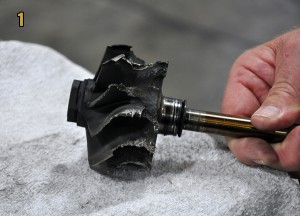 Let’s talk about turbochargers. Dirty oil will attack a turbocharger faster than any other part on the diesel engine. When pulling a hill, the turbo can spin as fast as 112,000 RPM, and the ONLY item that keeps it cool, lubricated, and metal from touching metal is engine oil! It HAS to be clean! We have been taking pictures of turbochargers that have failed because of abuse, lack of lubrication, shutting down the engine when the exhaust gas temperature is above 300 degrees (you have to allow your engine to cool down before turning the key off), and drivers with a heavy right foot that repeatedly jab at the accelerator.
Let’s talk about turbochargers. Dirty oil will attack a turbocharger faster than any other part on the diesel engine. When pulling a hill, the turbo can spin as fast as 112,000 RPM, and the ONLY item that keeps it cool, lubricated, and metal from touching metal is engine oil! It HAS to be clean! We have been taking pictures of turbochargers that have failed because of abuse, lack of lubrication, shutting down the engine when the exhaust gas temperature is above 300 degrees (you have to allow your engine to cool down before turning the key off), and drivers with a heavy right foot that repeatedly jab at the accelerator.
Years ago, I wrote about driving a semi-truck as though you have an uncooked egg under your right foot to illustrate that you need to go easy on and easy off the throttle. We need to go back to the basics of driving in order to keep the turbochargers alive and healthy!
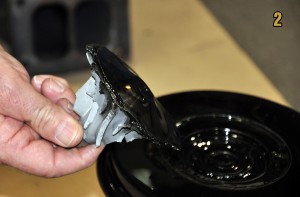 There are only three manufacturers of turbos in the USA – Holset, Borg Warner and Air Research. We do not make turbochargers at Pittsburgh Power. We do, however, specify to the manufacturers which housing and wheels we want in the turbochargers we sell. Please don’t call me and tell me that “my” turbo is junk because you broke it – we do not manufacture the turbo. If you have scrapped out several turbochargers, you need to ask yourself, “What am I doing wrong?” However, this does not pertain to the VG-turbos on EGR engines built from 2003 to present – they have their own problems. Here, now, I am writing about turbos for 2002 and older engines.
There are only three manufacturers of turbos in the USA – Holset, Borg Warner and Air Research. We do not make turbochargers at Pittsburgh Power. We do, however, specify to the manufacturers which housing and wheels we want in the turbochargers we sell. Please don’t call me and tell me that “my” turbo is junk because you broke it – we do not manufacture the turbo. If you have scrapped out several turbochargers, you need to ask yourself, “What am I doing wrong?” However, this does not pertain to the VG-turbos on EGR engines built from 2003 to present – they have their own problems. Here, now, I am writing about turbos for 2002 and older engines.
The pictures below show you the damage to the turbo and what the cause was: #1 Turbine wheel hit by pieces of engine that came out through the exhaust manifold; #2 Broken turbine shaft caused by pushing too hard on the accelerator which causes the turbine wheel to spool up too quickly (this is also caused by rapid deceleration); #3 Dirty oil wiped out the turbo bearings (the bearing spins at half the rate of the turbine shaft – at idle, the bearings are spinning at 4,000 RPM while the wheels and shaft are at 8,000 RPM); #4 Heat cracks, which result from lugging the engine (pulling hills at 1,100 to 1,300 RPM, which is too low), driving without a working pyrometer, having a clogged air filter, or by leaks in the charge-air system; and #5 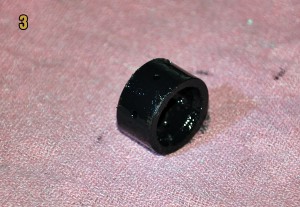 Turbo throwing oil when a crossover hose blows. The turbo is alright, just replace the hose and remove and clean the compressor. When the hose bursts while pulling a hill, all of the air escapes and the pressure differential behind the compressor allows oil to escape from the turbo. This is not a problem – the turbo will stop leaking once the hose is replaced.
Turbo throwing oil when a crossover hose blows. The turbo is alright, just replace the hose and remove and clean the compressor. When the hose bursts while pulling a hill, all of the air escapes and the pressure differential behind the compressor allows oil to escape from the turbo. This is not a problem – the turbo will stop leaking once the hose is replaced.
Turbochargers are very sensitive pieces of equipment and are many times abused during every day driving conditions. They are put through hell, and to survive they need clean oil, clean air filters, unrestricted blow-by tubes, and cool exhaust gas temperatures (around 300 degrees) before the key is turned off. And, of course, it helps to have a gentle right foot on the throttle, especially if you have an engine built for high performance!
It’s winter again, which is the best time of the year – especially if you love to ride snowmobiles! This year, we are having our annual Owner Operator Snowmobile Conference in Montana. If you have never ridden an 800 c.c. mountain sled with a bunch of other owner operators, you are missing out on a great opportunity. We all know how diesel fanatics are when pulling a load up a mountain – well, it’s the same when you’re on a performance sled and the mountain is in front of you along with 20+ other guys with the same attitude!
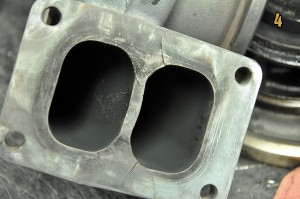 During the conference, we snowmobile by day and then meet for a few drinks and dinner at night to talk about trucks, and, of course, snowmobiling. This conference is tax deductible – it is a business expense. At the end of the three days you will not only have had the vacation of a lifetime, but you will also have a bunch of new friends and know a lot more about your truck. We will be arriving on Thursday, February 27th, and ride on Friday, Saturday and Sunday. Plan to depart on Monday, March 3, 2014. We are staying at the Kelly Inn, located in West Yellowstone, Montana (800-259-4672). A block of rooms are being held under Pittsburgh Power. Contact them directly to reserve one of these rooms by January 11, 2014.
During the conference, we snowmobile by day and then meet for a few drinks and dinner at night to talk about trucks, and, of course, snowmobiling. This conference is tax deductible – it is a business expense. At the end of the three days you will not only have had the vacation of a lifetime, but you will also have a bunch of new friends and know a lot more about your truck. We will be arriving on Thursday, February 27th, and ride on Friday, Saturday and Sunday. Plan to depart on Monday, March 3, 2014. We are staying at the Kelly Inn, located in West Yellowstone, Montana (800-259-4672). A block of rooms are being held under Pittsburgh Power. Contact them directly to reserve one of these rooms by January 11, 2014.
Snowmobile rentals are available at Yellowstone Adventures (800-231-5991) for Ski Doo snowmobiles. Mention that you are staying at the Kelly Inn for a 10% discount. The closest 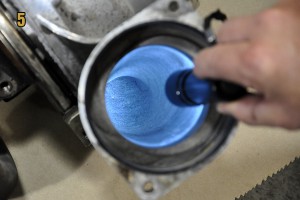 airport is Bozeman, Montana, which is 90 miles away. There is a shuttle service provided by Karst Stage (800-845-2778). Your flight must arrive by 1:30 p.m. on Thursday and depart after 1:00 p.m. on Monday. There is plenty of truck and trailer parking in West Yellowstone, and once you are there, you will not need to use your vehicle, as the entire town is snowmobile accessible, as are all of the restaurants, and even the IMAX theater! If you have never ridden a snowmobile before, we will teach you, and we’ll teach you the fast and proper way to mountain ride! For more information, I can be reached at Pittsburgh Power in Saxonburg, PA at (724) 360-4080 or via e-mail at bruce1@pittsburghpower.com.
airport is Bozeman, Montana, which is 90 miles away. There is a shuttle service provided by Karst Stage (800-845-2778). Your flight must arrive by 1:30 p.m. on Thursday and depart after 1:00 p.m. on Monday. There is plenty of truck and trailer parking in West Yellowstone, and once you are there, you will not need to use your vehicle, as the entire town is snowmobile accessible, as are all of the restaurants, and even the IMAX theater! If you have never ridden a snowmobile before, we will teach you, and we’ll teach you the fast and proper way to mountain ride! For more information, I can be reached at Pittsburgh Power in Saxonburg, PA at (724) 360-4080 or via e-mail at bruce1@pittsburghpower.com.
